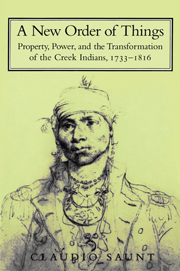Introduction
Published online by Cambridge University Press: 25 July 2009
Summary
On the Flint River in June 1801 in what is now Crawford County,Georgia, a United States Indian agent named Benjamin Hawkins spoke to Creek leader Efau Hadjo about a pressing problem: obtaining “supplys for those who from age and old habits could not be immediately benefitted by the new order of things.” His concerns reflected a confidence in the future. He would attempt to smooth a rough road – to feed and clothe those lagging behind – but no matter how many were lost on the way, he was certain of the destination. Not all Creeks shared his conviction. Efau Hadjo told the agent that the “old Chiefs and their associates in opposition” not only failed to benefit from the “new order of things,” but they in fact hoped to destroy it. This book is about the rise of the new order, a great transformation that overturned Creek lives in the three decades following the American Revolution.
Order and things, or power and property, are its subject. Before the Revolution, individual Creeks neither claimed nor asserted coercive power over their neighbors. Leaders created political order by persuasion rather than force. By the second decade of the nineteenth century, in contrast, a “national council” composed of a few dozen men asserted its rule over every Creek person. The council executed those who disobeyed its orders. A similarly dramatic change occurred in the realm of property.
- Type
- Chapter
- Information
- A New Order of ThingsProperty, Power, and the Transformation of the Creek Indians, 1733–1816, pp. 1 - 8Publisher: Cambridge University PressPrint publication year: 1999

